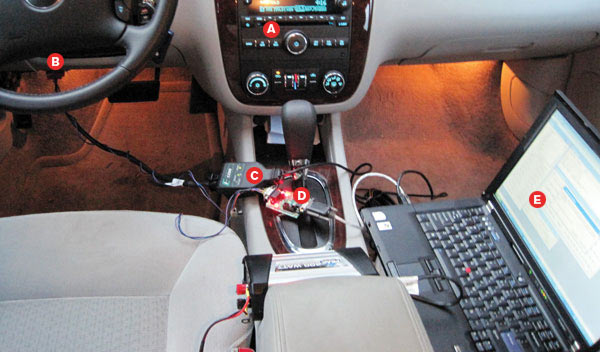Taking Over a Car

Cars are becoming more computerized, an evolution that could have an unintended side effect: vulnerability to attacks. Researchers at the University of Washington and the University of California, San Diego, led by Tadayoshi Kohno and Stefan Savage, recently showed that by taking over a car’s computers, they could disable the brakes, stop the engine, and control the door locks. For now, most of the attacks require access to a port inside the car. But wreaking havoc could get easier as carmakers add more wireless connectivity. The researchers hope their work will motivate manufacturers to add security features.
A. Computerized Systems
A typical luxury sedan contains 50 to 100 computers controlled by over 100 megabytes of code. Most of these computers communicate over a shared internal network. These systems have surprising interconnections that attackers could exploit, the researchers say. For example, in many cars, the door locking system and the crash detection system are linked. That means an attacker who takes over the locks may get access to key internal systems.
B. Onboard Diagnostics Port
U.S. law mandates an onboard diagnostics port, which is located under the dashboard in most cars. The researchers gain access to the car’s computer systems by plugging into it.
C. Communications Cable
The researchers used this cable to connect to the car’s high-speed communications network, which contains the engine control module, the electronic brake control module, and the transmission control module. The car uses a protocol that enables all these components to communicate with each other. The cable converts data sent using this protocol to a USB signal that can be received by an ordinary laptop.
D. Custom-built Connection
A low-speed network connects less critical parts of the car’s computer system, such as the air conditioning, the radio, and the theft deterrent module, which prevents the car from starting without a legitimate key. The researchers loaded their own code onto a circuit board, which was then able to translate between the laptop and the car’s systems.
E. Carshark Interface
The researchers developed a custom “CarShark” interface–which can run on an ordinary laptop–to track and control the messages that various computer systems send each other over the car’s networks. They executed their attacks through this interface, and in some cases they sent it wireless commands from a nearby car.
Photo Credit: Karl Koscher, Alexei Czeskis, and Franzi Roesner
Keep Reading
Most Popular
Large language models can do jaw-dropping things. But nobody knows exactly why.
And that's a problem. Figuring it out is one of the biggest scientific puzzles of our time and a crucial step towards controlling more powerful future models.
The problem with plug-in hybrids? Their drivers.
Plug-in hybrids are often sold as a transition to EVs, but new data from Europe shows we’re still underestimating the emissions they produce.
Google DeepMind’s new generative model makes Super Mario–like games from scratch
Genie learns how to control games by watching hours and hours of video. It could help train next-gen robots too.
How scientists traced a mysterious covid case back to six toilets
When wastewater surveillance turns into a hunt for a single infected individual, the ethics get tricky.
Stay connected
Get the latest updates from
MIT Technology Review
Discover special offers, top stories, upcoming events, and more.